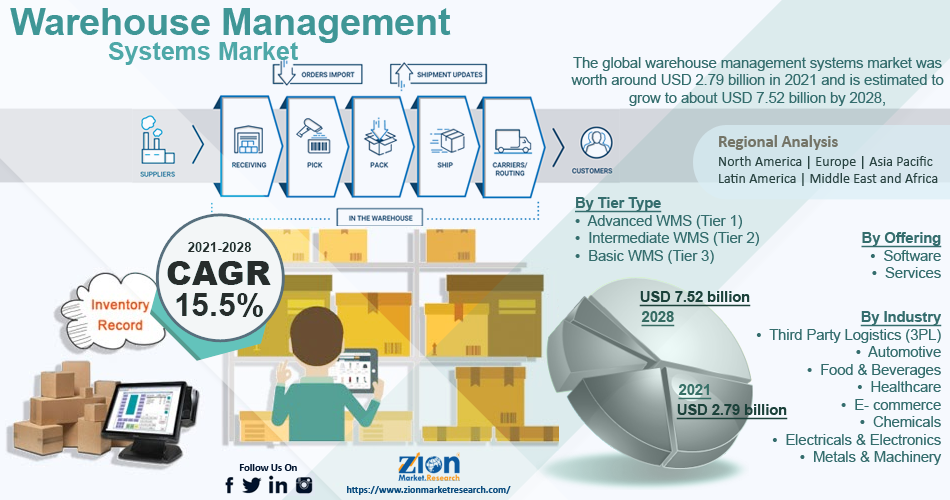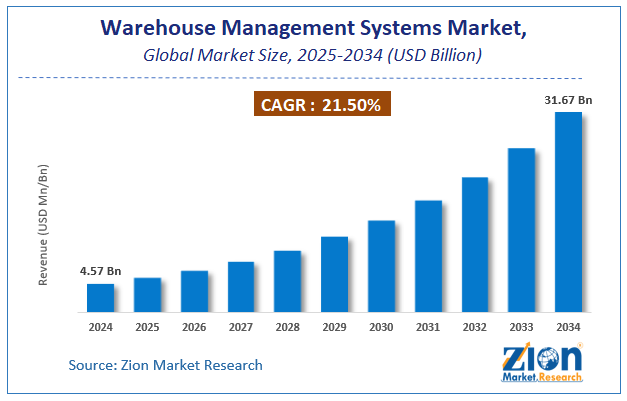Warehouse Management Systems Market Size Global Report, 2028

Warehouse Management Systems Market - By Offering (Software and Services), By Tier Type (Advanced WMS (Tier 1), Intermediate WMS (Tier 2), and Basic WMS (Tier 3)), By Industry (Third Party Logistics (3PL), Automotive, Food & Beverages, Healthcare, E-commerce, Chemicals, Electricals & Electronics, Metals & Machinery, and Others), and By Region: Global and Regional Industry Overview, Market Intelligence, Comprehensive Analysis, Historical Data, and Forecasts 2022 - 2028
| Market Size in 2021 | Market Forecast in 2028 | CAGR (in %) | Base Year |
|---|---|---|---|
| USD 2.79 Billion | USD 7.52 Billion | 15.5% | 2021 |
Warehouse Management Systems Market: Industry Perspective
The global warehouse management systems market size was worth around USD 2.79 billion in 2021 and is predicted to grow to around USD 7.52 billion by 2028 with a compound annual growth rate (CAGR) of roughly 15.5% between 2022 and 2028.
The report analyzes the global warehouse management systems market's drivers, restraints/challenges, and the effect they have on the demands during the projection period. In addition, the report explores emerging opportunities in the warehouse management systems industry.
Warehouse Management Systems Market: Overview
A warehouse management system (WMS) is a sort of organizing software that helps businesses keep a record of every item that enters and departs their warehouse, and every activity that takes place during the order fulfillment process. The WMS logs and updates its system whenever an item is withdrawn from storage or packaged for transportation. Using a WMS guarantees that inventory data are completely correct, allowing distributors to fulfill orders and restock products. When a WMS is implemented, inventory may leave the warehouse faster and orders have considerably greater accuracy. Most essential, clients have more confidence in their warehouse partner when they know their goods will be dispatched swiftly and precisely every time.
The warehouse management system is a vital part of the supply chain strategy as it controls the movement of goods and storage materials within the warehouse. This includes the processes associated with transactions such as receiving, shipping, putting away, and picking. Warehouse management systems also direct and make the most out of stock that has been put away based on the actual standing of bin operation. Therefore warehouse automation is the entire warehouse management cycle from the point that goods are received at the warehouse up to the delivery of customer's orders.
COVID-19 Impact:
Owing to strict lockdowns imposed by governments in many nations, several companies faced severe cash flow issues. Also, the worldwide shutdown and halt of production of metals & machinery, automotive, and other sectors have resulted in a decline in demand for warehouse management systems in 2020 to some extent.
However, despite the initial disarray created by the COVID-19 pandemic, the market grew steadily because of strong development in the e-commerce sector and greater user knowledge of the benefits of warehouse management systems. Furthermore, the crisis has pushed many industries to adopt warehouse automation solutions such as warehouse management systems.
Global Warehouse Management Systems Market: Growth Drivers
Increase in the necessity for automation to foster market growth
The global warehouse management systems market is expanding at an astounding rate as a result of the growing need for automation in distribution centers, warehouses, and logistics networks. More warehouses are in high demand across the businesses. Apart from constructing new warehouses, large retailers have converted existing shopping malls into new distribution facilities. Furthermore, the number of people required to fill warehouse roles is likely to rise further. The capacity to fulfill orders and transfer items will impact customer service and profitability as the sector grows.
As a result, an increasing number of businesses are contemplating implementing warehouse management systems, including upgrading to whole new systems. Further, the growth of E-Commerce and Omnichannel is the key reason for the adoption of warehouse management systems that are equally contributing to the growth of the global market. With the ease of use, warehouse management systems offer crucial benefits such as inventory optimization and visibility, including slotting and order streaming.
Global Warehouse Management Systems Market: Restraints
High investment is required in setting up on-premise WMS for SMEs
High-end on-premises WMS solutions have a high setup cost, which is preventing SMEs from adopting them. Constant hardware updates and on-premises WMS maintenance expenditures are significant drawbacks that in turn are restraining the growth of the global warehouse management systems market.
 Request Free Sample
Request Free Sample
Warehouse Management Systems Market: Opportunities
The advent of the modern cloud-based warehouse management system
Disrupting supplier markets, changing customer buying behaviors, and increasing supply chain complexity are examples of such operations that must respond to the changes with their own digitally linked solutions. Digital technology and the internet have revolutionized warehouse management platforms. It has changed the customer's purchasing behavior. Moving warehouse management systems to the cloud will allow them to link consumers with a connected fulfillment solution that provides real-time scalability, visibility, and market responsiveness.
Warehouse Management Systems Market: Challenges
Lack of knowledge about warehouse management systems among small and middle-scale industries
Small and middle-scale enterprises have historically used legacy technologies to run their warehouses. Due to the low yearly income of small-scale enterprises, expenditures to set up WMS appear to be a needless outlay for these business owners. Additionally, they have a limited workforce, and hiring a trained individual to maintain WMS may be a time-consuming and costly process. Business owners in small-scale businesses struggle to grasp the benefits of employing WMS due to a reluctance to change existing systems and constrained development plans.
Global Warehouse Management Systems Market: Segmentation
The global warehouse management systems market is categorized based on offering, tier type, industry, and region.
Based on the offering, the market is segregated into software and services. Among these, the software segment holds the major share of the market whereas, the services segment is expected to grow at a rapid rate over the forecast period.
The tier type segment of the market is bifurcated as advanced WMS (Tier 1), intermediate WMS (Tier 2), and basic WMS (Tier 3).
By industry, the global market is divided into automotive, third-party logistics (3PL), food & beverages, healthcare, chemicals, metals & machinery, commerce-commerce, electricals & electronics, and others. Among these, the third-party logistics (3PL) segment holds a significant share of the market.
Warehouse Management Systems Market: Report Scope
| Report Attributes | Report Details |
|---|---|
| Report Name | Warehouse Management Systems Market |
| Market Size in 2021 | USD 2.79 Billion |
| Market Forecast in 2028 | USD 7.52 Billion |
| Growth Rate | CAGR of 15.5% |
| Number of Pages | 185 |
| Key Companies Covered | Infor Inc., Tecsys, Inc., SAP SE, Oracle Corporation, HighJump Software Inc., Interlink Technologies, Softeon, Inc., Logfire, Inc., Manhattan Associates, Inc., and Jda Software Group, Inc., and others. |
| Segments Covered | By Offering, By Tier Type, By Industry, and By Region |
| Regions Covered | North America, Europe, Asia Pacific (APAC), Latin America, The Middle East and Africa (MEA) |
| Base Year | 2021 |
| Historical Year | 2018 to 2021 |
| Forecast Year | 2022 - 2028 |
| Customization Scope | Avail customized purchase options to meet your exact research needs. Request For Customization |
Warehouse Management Systems Market: Regional Landscape
North America is likely to lead the global warehouse management systems markets during the forecasted period. This is attributed to increasing automation in large chains of warehouses, the rapid expansion of e-commerce platforms, and the high spending power of enterprises in the region. Major countries in the region such as the US and Canada are home to major logistics companies. Also, other sectors such as automobile, chemical, and food & beverage that require warehouses are well developed in these countries which is strongly supporting the growth of the market. The Asia Pacific is expected to be the fastest-growing market for warehouse management systems.
The significant rise of the manufacturing and e-commerce sector in emerging economies like India, China, and Indonesia is mainly responsible for the rapid expansion of the market in this region. Due to its large industrial and manufacturing sector, China is expected to be the major revenue contributor to the warehouse management systems market in APAC. Whereas, India is one of the most rapidly increasing markets for warehouse management systems in the region.
Recent Developments
- Manhattan Associates introduced a unique Manhattan Active warehouse management solution in May 2020, a cloud-based enterprise-level warehouse management system that integrates all aspects of distribution and never has to be upgraded.
- In August 2021, Lucas Systems, the largest provider of voice and warehouse optimization software for shipping and distribution facilities, revealed a collaboration with Fetch Robotics, located in Silicon Valley, to empower the next generation of smart warehouses.
Warehouse Management Systems Market: Competitive Landscape
Major players operating in the global warehouse management systems market include;
- Infor Inc.
- Tecsys, Inc.
- SAP SE
- Oracle Corporation
- HighJump Software Inc.
- Interlink Technologies
- Softeon, Inc.
- Logfire, Inc.
- Manhattan Associates, Inc.
- Jda Software Group, Inc.
The Global Warehouse Management Systems market is segmented as follows:
By Offering
- Software
- Services
By Tier Type
- Advanced WMS (Tier 1)
- Intermediate WMS (Tier 2)
- Basic WMS (Tier 3)
By Industry
- Third-Party Logistics (3PL)
- Automotive
- Food & Beverages
- Healthcare
- E-commerce
- Chemicals
- Electricals & Electronics
- Metals & Machinery
- Others
By Region
- North America
- The U.S.
- Canada
- Europe
- France
- The UK
- Spain
- Germany
- Italy
- Rest of Europe
- Asia Pacific
- China
- Japan
- India
- South Korea
- Southeast Asia
- Rest of Asia Pacific
- Latin America
- Brazil
- Mexico
- Rest of Latin America
- Middle East & Africa
- GCC
- South Africa
- Rest of the Middle East & Africa
Table Of Content
Methodology
FrequentlyAsked Questions
The global warehouse management systems market is expanding at an astounding rate as a result of the growing need for automation in distribution centers, warehouses, and logistics networks. More warehouses are in high demand across the business.
According to a study, the global warehouse management systems market size was worth around USD 2.79 billion in 2021 and is expected to reach USD 7.52 billion by 2028 at a CAGR of 15.5% during the forecast period.
North America is likely to lead the global warehouse management systems markets during the forecasted period.
Major players operating in the global warehouse management systems market include Infor Inc., Tecsys, Inc., SAP SE, Oracle Corporation, HighJump Software Inc., Interlink Technologies, Softeon, Inc., Logfire, Inc., Manhattan Associates, Inc., and Jda Software Group, Inc.
The warehouse management systems market report covers the geographical market along with a comprehensive competitive landscape analysis. It also includes cash flow analysis, profit ratio analysis, market basket analysis, market attractiveness analysis, sentiment analysis, PESTLE analysis, trend analysis, SWOT analysis, trade area analysis, demand & supply analysis, Porter’s five forces analysis, and value chain analysis.
RelatedNews
HappyClients
Zion Market Research
Tel: +1 (302) 444-0166
USA/Canada Toll Free No.+1 (855) 465-4651
3rd Floor,
Mrunal Paradise, Opp Maharaja Hotel,
Pimple Gurav, Pune 411061,
Maharashtra, India
Phone No +91 7768 006 007, +91 7768 006 008
US OFFICE NO +1 (302) 444-0166
US/CAN TOLL FREE +1 (855) 465-4651
Email: sales@zionmarketresearch.com
We have secured system to process your transaction.
Our support available to help you 24 hours a day, five days a week.
Monday - Friday: 9AM - 6PM
Saturday - Sunday: Closed






